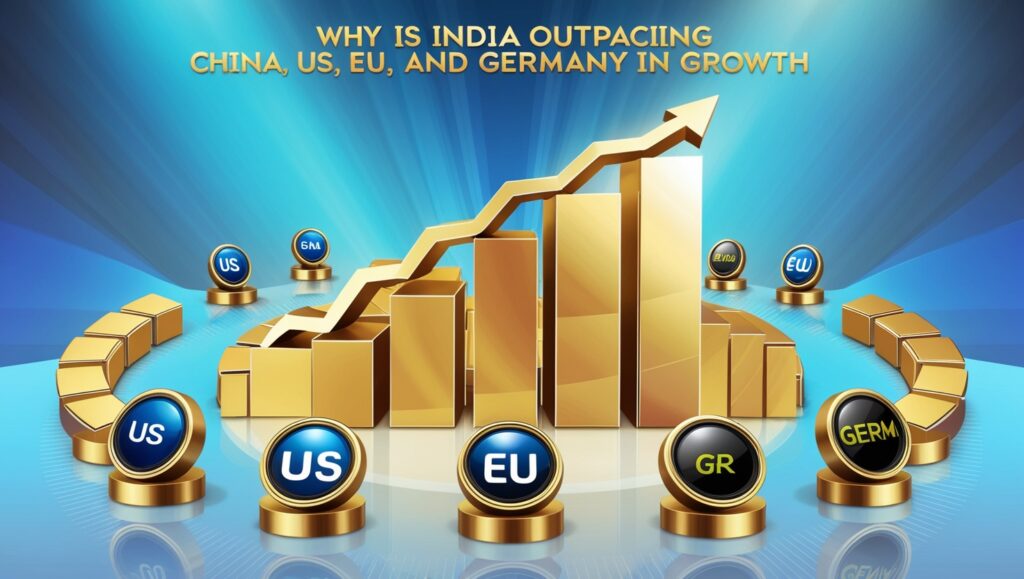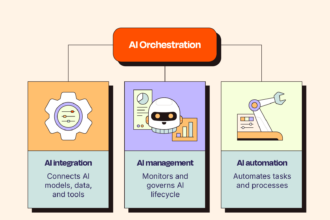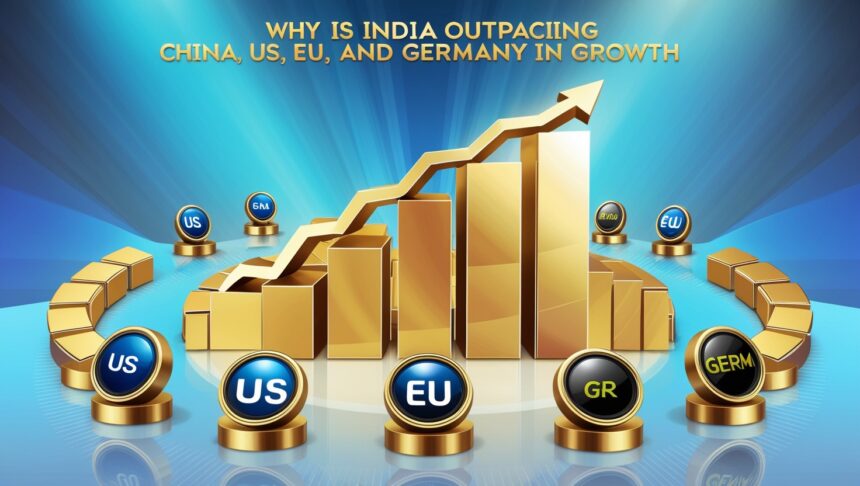In this post, I will discuss the Why Is India Outpacing China, US, EU, and Germany in Growth.
India’s wedge shaped competitive advantages like a youthful demographic, quick pivot towards technology, aggressive policy changes and increasing self-sufficiency are propelling its growth. Knowing these factors outlines why India is one of the foremost global emerging growth engines today.
Overview
The world is now noticing India’s economic growth due to the fact that it is outpacing former giants of the economy such as China, the United States, Germany, and even the European Union.
With these countries having maintained their positions as financal powerhouses for so long, India’s distinctive strengths along with its recent set of reforms are propelling it towards unprecedented levels of growth.
This change enhances India’s role in global economy and geopolitics while simultaneously changing the balance of global power.
Why Is India Outpacing China, US, EU, and Germany in Growth?

Demographic Dividend: A Youthful Workforce
India is one of the youngest populations in the world and unlike the US, EU, Germany or China which has an aging workforce due to strict family planning policies. Moere than half of India’s population is aged under 25, suggesting that India could make use of a increasing workforce for innovation and productivity for many years ahead.
In addition to expanding the available talent pool, this also increases participation in spending driving local demand. The younger generation tends to focus consumer attention on education as well as technology along both white-collar and blue-collar housing jobs which shifts the economy from depending on exports like China does towards being domestically driven. This engenders positive feedback and growth.
Digital Revolution and Technology Adoption
India’s digital transformation has become one of the biggest drivers of its economic growth. Initiatives such as Digital India have provided internet access to over 800 million people, including those from rural areas.
This connectivity has spurred growth in e-commerce, fintech, online education, and telemedicine. India’s strong IT and software services industry based in Bengaluru and Hyderabad continues to attract global clients and investment. While China relies on manufacturing for economic growth, India utilizes technology and services as a strength which helps integrate into the global economy.
Payment platforms like Paytm and Google Pay have financial inclusion in underserved regions due to mobile payments. Moreover adoption of new technologies such as AI and blockchain are shifting India’s innovation landscape with these technologies accelerating their use, driving other economies lagging behind them out.
Bold Economic Reforms and Policy Initiatives
India’s Government has started reforms to improve the business climate. The Goods and Services Tax (GST) was an important step in unifying the fragmented tax system, allowing greater ease of interstate business operation. Entrepreneurship and innovation is supported by firmer labor regulations and a relaxation of rules.
Encouraging more investment and reducing imports is at the heart of “Make in India” campaign which seeks to expand domestic manufacturing even more, wooing foreign multinationals to set up production facilities. These reforms are meant to increase competitiveness, foster greater employment opportunities, and diversify India’s economy.
Expanding Domestic Market and Rising Middle Class
The increasing middle class and the expanding domestic market in India are crucial to its striking economic growth. India has over 1.4 billion people which makes it one of the largest and fastest growing consumer bases across the globe.
Metropolitan cities coming up as well as increasing income are augmenting the demand for healthcare, housing, automobiles, electronics and even financial services.
In contrast to export driven economies, India’s growth is based on strong internal consumption, providing a buffer against global economic shocks.
The middle-class population is embracing lifestyle changes including digital services which further strengthens retail and other modern sectors; this group now exceeds 300 million people.
Attracting local entrepreneurs and foreign investors with ease, this rise strengthens self-sustaining cycles of economic development not seen in many advanced economies.
Thriving Start-up and Innovation Ecosystem
In the last decade, India has undergone a transformation in business activity and opportunity. There are now more than 100 “unicorns”—startups valued at over $1 billion—which makes India one of the leading countries in the world for startup business activity.
Govt programs like ‘Startup India offer grants, guidance and even regulatory assistance to aid new idea development.
The increased rate of more entrepreneurial units is supporting technologies that unlock various possibilities leaping past infrastructure stages of growth by embracing AI, blockchain, and fintech innovations.
This powerful India innovation magnet is supported with overseas industry investment capital as well as strengthens India’s growth-oriented tech economy.
Strategic Global Positioning and Trade Opportunities
India’s strategically located passport and its growing opportunities for international trade are critical in accelerating India’s growth.
India’s relations with other countries have evolved, and so has its relationship with the US, Japan, and Australia as it increased collaboration with these nations on trade, technology, and defense.
There are also regional forums such as Quad and G20 which India is actively participating in where its global standing is improved.
The country is working towards a favorable policy balance to reduce dependency on one major market and amidst global supply chain shifts there are companies that want alternatives to China.
Government policies along with better infrastructure are rapidly supporting export sectors such as pharmaceuticals, textiles or electronics.
These changes allow India to shift into advanced stages of developmental integration which strengthens the economy while establishing a strategic position globally.
Challenges Ahead

Along with its booming economy, India still faces several challenges that can greatly affect its growth in the long-run. Glaring infrastructure gaps like roads, limited power supply and urban facilities present constrains to productivity and investment potential.
Widening social inequalities paired with inaccessible quality education, healthcare, and job opportunities slow down more inclusive growth.
Moreover air pollution, depletion of water resources, and other environmental concerns put sustainable development at risk. Alongside this India faces regulatory complexities and red-tape hurdles that stifle entrepreneurship and deter foreign direct investment which needs to be addressed as well.
Striking a balance between human capital investment along economic reforms while containing strict environmental priorities is vital if all citizens are to benefit from India’s projected growth.
Conclusion
To wrap things up, China, the US, the EU and Germany are all having slower growth compared to India. This is due to a multitude of reasons. The adoption of new digital technology is improving alongside bold reforms in the economy which gives room for further investment.
Changing demographics in India also plays a vital role where developed economies are facing stagnation with increasing aging populations.
Economically, India benefits from a thriving services sector and strategic global economic partnerships also strengthen India’s position in trade further increasing New Delhi’s control over world markets.
Despite challenges existing, exploiting demographic advantages paired with technology holds promise that lean globalization policies over the next few decades can transform this already industrial hub into one of the biggest emerging economies in the world.














